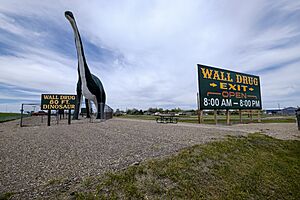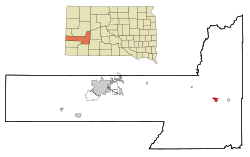Wall, South Dakota facts for kids
Quick facts for kids
Wall, South Dakota
Makȟóšiča Aglágla Otȟuŋwahe
|
|
|---|---|
 |
|

Location in Pennington County and the state of South Dakota
|
|
| Country | United States |
| State | South Dakota |
| County | Pennington |
| Incorporated | 1908 |
| Area | |
| • Total | 2.71 sq mi (7.02 km2) |
| • Land | 2.63 sq mi (6.81 km2) |
| • Water | 0.08 sq mi (0.21 km2) |
| Elevation | 2,815 ft (858 m) |
| Population
(2020)
|
|
| • Total | 699 |
| • Density | 265.78/sq mi (102.62/km2) |
| Time zone | UTC−7 (Mountain (MST)) |
| • Summer (DST) | UTC−6 (MDT) |
| ZIP code |
57790
|
| Area code(s) | 605 |
| FIPS code | 46-68380 |
| GNIS feature ID | 1267622 |
| Website | Wall, SD |
Wall is a town in Pennington County, South Dakota, United States. Its name in the Lakota language is Makȟóšiča Aglágla Otȟuŋwahe, which means "Town alongside the Badlands". In 2020, about 699 people lived there.
Contents
History of Wall, South Dakota
Wall was first planned in 1907. This was when the Chicago and North Western Railroad tracks reached this spot. The town officially became a town in 1908. It was named Wall because of the "natural wall" of rock formations. These formations are found near the Badlands National Park.
Famous Wall Drug Store
The town is most famous for the Wall Drug Store. It started as a small pharmacy in 1931. This was during the Great Depression, a time when many people had little money. Over time, it grew into a very large and popular place for tourists. People traveling through the area often stop there.
National Grasslands Visitor Center
The National Grasslands Visitor Center is also in Wall. This center helps visitors learn about the nearby Buffalo Gap National Grassland. It teaches about the plants, animals, and history of the area.
Geography of Wall
Wall is located in Pennington County. It is on the eastern side of the county. The town is also located across the Cheyenne River. This makes it the biggest town in that part of the county.
The town covers about 2.22 square miles (5.75 square kilometers) of land and water. Most of this area is land.
Population and People
| Historical population | |||
|---|---|---|---|
| Census | Pop. | %± | |
| 1910 | 167 | — | |
| 1920 | 224 | 34.1% | |
| 1930 | 326 | 45.5% | |
| 1940 | 500 | 53.4% | |
| 1950 | 556 | 11.2% | |
| 1960 | 629 | 13.1% | |
| 1970 | 786 | 25.0% | |
| 1980 | 770 | −2.0% | |
| 1990 | 834 | 8.3% | |
| 2000 | 818 | −1.9% | |
| 2010 | 766 | −6.4% | |
| 2020 | 699 | −8.7% | |
| U.S. Decennial Census | |||
In 2010, there were 766 people living in Wall. There were 359 homes and 212 families. About 88.9% of the people were White. About 7.0% were Native American. The rest were from other racial backgrounds.
The average age of people in Wall was about 47 years old. About 21.4% of the residents were under 18 years old. About 19.6% were 65 years or older.
Getting Around Wall
Wall has its own small airport called the Wall Municipal Airport. It is used for general aviation, which means it's for private planes. It is less than a mile northwest of the town. The city of Wall owns this airport.
You can also get to Wall by bus. Jefferson Lines provides bus service to the town.
Education in Wall
Students in Wall attend schools that are part of the Wall School District 51-5.
See also
 In Spanish: Wall (Dakota del Sur) para niños
In Spanish: Wall (Dakota del Sur) para niños


